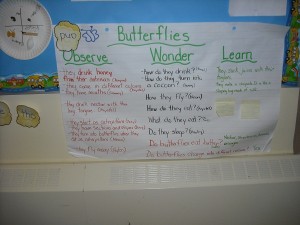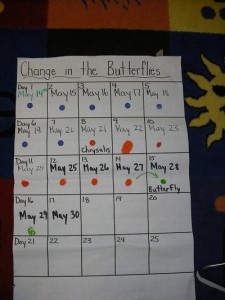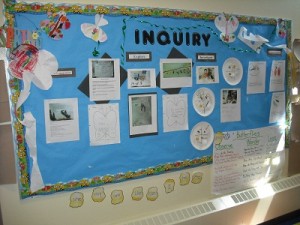 Our Inquiry on Growth and Change integrated the discovery of Butterflies.
Our Inquiry on Growth and Change integrated the discovery of Butterflies.
We created OWL (KLW) chart to see what the children already knew and had previously observed about butterflies.
We started asking questions about butterflies and observed the caterpillars in their jars and later they began forming their chrysalises. It was a great time to review questioning and how to formulate one. Once we discussed and read about butterflies the children began to develop deeper questions. For example; I wonder if butterflies can fly? to questions like… I wonder how they know when their enemies are coming? We also reviewed diagrams and how to label parts.
We created a chart to record how long it takes (passage of time) for the butterflies to change; from caterpillar to chrysalis, and chrysalis to butterfly. Some did not change all at the same time, and we compared our observations of change to what had been noted in videos and readings.
Students documented their observations in their journals.
We created an “I wonder” binder for the centre where children freely recorded their questions.
The children, along side the educators researched our questions through books, internet, and through short YouTube videos.
At the craft centre, children had the option to show their learning through recreating the life cycle with natural materials found outside to represent the different stages–real leaves, sticks, tree seeds for caterpillar bodies!
In the end, the children communicated to us their new learning through a written response and oral discussion. We released the butterflies at the 3 week period and we read an aboriginal legend about whispering a wish when you release the butterfly.
Here is a great website from the research project in Reggio schools in Italy. There is some great information and pictures about documentation.
Main Page that will tell you about the project http://www.mlvpz.org/index.html
Documentation samples http://www.mlvpz.org/documentation/index.html
Today I had an opportunity to read through some research on why documentation is important to student learning. In the attached article http://www.edu.gov.on.ca/eng/literacynumeracy/inspire/research/CBS_Pedagogical.pdf there is some great reference points about how students learn and think and how we as teachers extend our understanding of documentation as we discuss, share and collaborate with colleagues. Another topic that was interesting was peer feedback. I tried this informally late last year and when I felt they were ready. I also tried a form of strengths and next steps (one star, one wish) in my literacy assessment. It was a great opportunity to have a conversation about the student work. Again, I did this in late February. I was amazed at how they were able to share not only what they are good at, but where they need to improve!!
Another important part that stood out the most for me was the accountability. We are constantly defending the play-based learning approach to parents, the public and what better way to display learning through prompts, pictures, and questioning. Display student work with their dialogue, questioning. Have their portfolios out and accessible for them to refer back to, display learning over time–history from previous years. Create a communication board on inquiry and show students engaged in learning! Have a read and enjoy!




Recent Comments